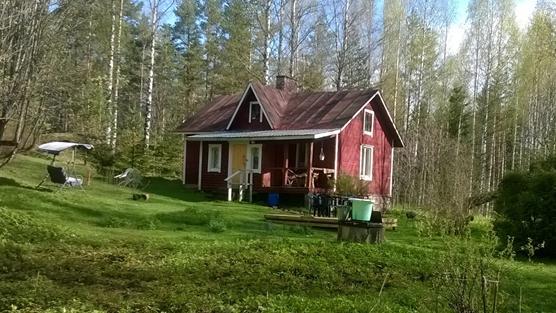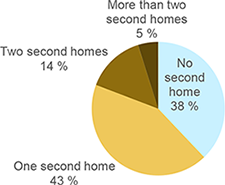Press release 2015-06-11 at 10:45

Even if summer cottages on average are getting bigger and better equipped, there are still Finns who fancy old and small. © Photo: Mia Vepsäläinen
Finnish Environment Institute's and University of Eastern Finland's press release
Finnish second home tourism no longer consists solely of holidaying at a modest summer cottage. Instead, Finns are increasingly spending time at second homes equipped for year round living. According to a new survey on second home tourism, more than half of second homes are suitable for winter use, and nearly nine out of ten are connected to the electrical grid.
While permanent living is increasingly concentrating in cities, the number of seasonal residents has increased in most parts of Finland. The number of second homes is at its highest in Finland's Lake District, coastal regions and Lapland's tourist centres. In one out of every five municipalities, second homes already outnumber permanent homes.
The Finnish Environment Institute (SYKE) and the University of Eastern Finland studied second home tourism and multiple dwelling in an international research project funded by the Academy of Finland. The final report of the study was published earlier this week. The results are based on extensive surveys targeted at Finnish citizens and municipal authorities, among other sources.
Municipalities have a positive attitude towards second home tourism

Regular access to second homes
Municipal authorities regard the effects of second home tourism on local economy, communities and the environment to be primarily positive. "Second home tourists are seen as maintaining local services and infrastructure," says researcher Mia Vepsäläinen from the University of Eastern Finland.
Municipalities consider shoreline housing development and the closing off of beaches to be the greatest negative impacts of second home tourism. "The majority of municipalities want to increase second home tourism in their area, but attitudes towards permanent living at summer cottages are mixed," Vepsäläinen continues.
As the standard of equipment of summer cottages has increased, they have increasingly become second homes, giving rise to the concept of multiple dwelling. "Current housing statistics and registers, which assume that a person only has a single place of residence, no longer provide a comprehensive view of population distribution over different parts of Finland and its impacts on local economy, planning and the organisation of services," says Vepsäläinen.
The majority of municipalities support the idea of second home tourists paying some of their income tax to their second home municipality. However, a slight majority would not give second home tourists the right to vote in municipal elections, or expand second home tourists' rights to use the public services of their second home municipality. One in four municipalities requires more resources for planning, especially as regards shoreline areas.
A part of Finnish culture now and in the future
According to the survey, just under two thirds of Finns regularly use a second home. Of these, 58% own their own second home, while the rest spend time at a cottage owned by someone else. Finnish second home tourists typically visit their second home 16 times a year, spending 37 nights there.
Czesław Adamiak, a Polish researcher who studied Finnish second home tourism in the project, is surprised at the extent and significance of second homes in Finland: "More than half of the Finnish spend their leisure time in one, two or several second homes. Second homes are the most widely used form of tourist accommodation in Finland. "
The most typical owners of second homes are pensioner couples, while families with children often visit second homes owned by relatives and friends. The majority of young people also spend time at second homes owned by their parents or relatives, with most of them intending to keep using a second home in the future as well or acquire a second home on their own.
Of those respondents who do not currently own a second home, approximately one in every five is planning to acquire one in the future. Of all the respondents, 20% believe that they themselves or someone else in their family will inherit a second home in the future.
Only a small share of the respondents is planning to move permanently to their second home, with only 0.4% of second home users reporting that they had decided to move to their second home within the next five years.
In addition to second homes, an increasing number of Finns also have a third home. As many as 19% of respondents reported that they have access to two or more second homes. Third homes are rarely self-owned: most people use second homes owned by relatives or friends in addition to their own cottage. On average, third homes are located further away than second homes. Many of them are located in the fells of northern Finland or in ski resorts, and are used more often during winter.
Second homes are used to break away from work and everyday life
People living in cities use second homes significantly more than those living in rural areas. Those living in dense residential areas and apartment buildings also spend more time at second homes compared to others. "Second home tourism can to some degree compensate for the stress, rush and noise experienced in urban environments, and for the lack of natural environments or having a private garden," says Senior Researcher Anna Strandell from SYKE.
The majority of Finns consider second home tourism to have only minor negative impacts on the environment, with only 4% being critical of the environmental impacts of their own second home tourism. However, the increasing use of private cars, current consumption behaviour and comprehensively equipped second homes are in fact increasing the negative environmental impacts of second home tourism. "In addition to this, second home tourism does not seem to be a substitute for long-haul tourism, as second home tourists take holiday trips abroad just as often as the rest of the population," says Strandell.
Means of transport used during travelling to second home and moving around in the location of second home
Report
The final report of the study was published in Finnish and in English in the Reports of the Finnish Environment Institute -series.
Adamiak, C. et al. Second home tourism in Finland – Perceptions of citizens and municipalities on state and development of second home tourism. Reports of the Finnish Environment Institute 22en/2015.
https://helda.helsinki.fi/handle/10138/155090Additional information
Home beyond homes (HOBO) - Multiple dwelling and everyday living in leisure spaces
http://www2.uef.fi/fi/secondhomes
Senior researcher Anna Strandell
Finnish Environment Institute SYKE
Tel. 0295 251 657
firstname.lastname@ymparisto.fi
University researcher Mia Vepsäläinen
University of Eastern Finland UEF
Tel. 046 921 3701
firstname.lastname@uef.fi (lastname = vepsalainen)
Communications expert Matti Lindholm
Finnish Environment Institute SYKE
Tel. 0295 251 380
firstname.lastname@ymparisto.fi
Twitter: @molindho